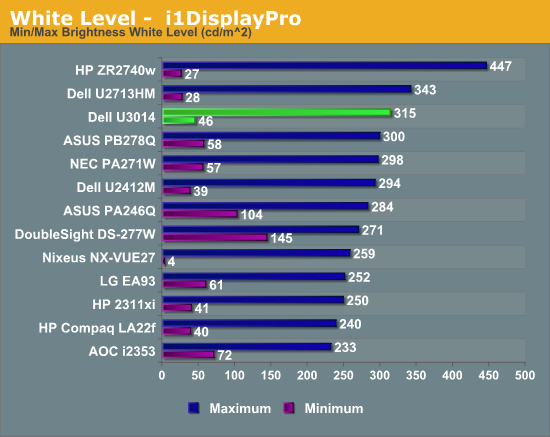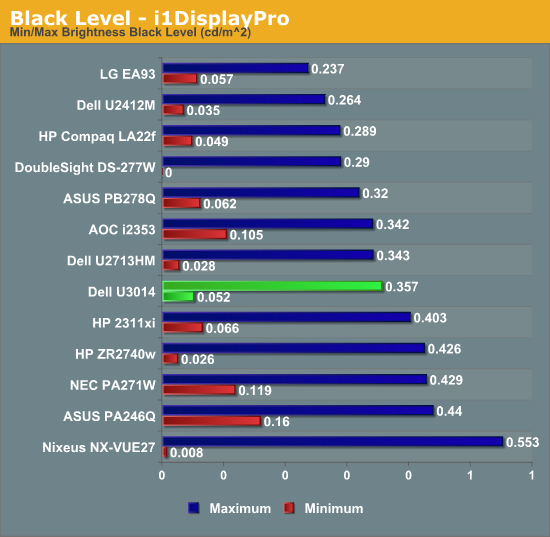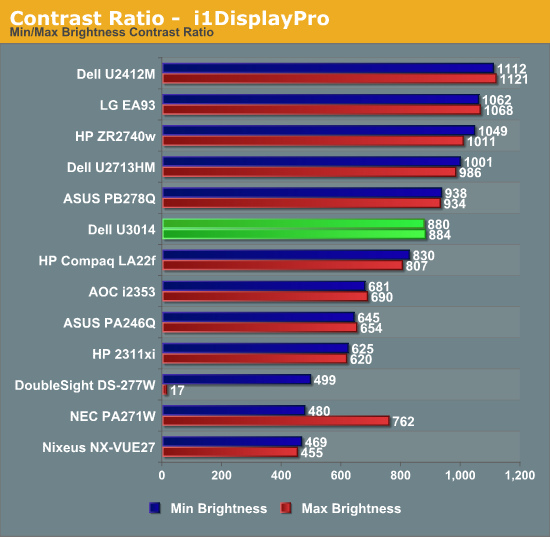Dell U3014 LCD Review
by Chris Heinonen on April 15, 2013 2:00 PM ESTThe Dell U3014 is rated for 350 cd/m2 on the spec sheet, but I found the most I could get it to produce was 315 cd/m2. It would likely produce more if you were to push the contrast all the way to the maximum, but doing so clips the top whites, so all your highlights suddenly become a single shade instead of distinct. It might make the numbers look worse, but not allowing clipping makes for an honest number, and 315 cd/m2 is what the U3014 can do. With the backlight at the minimum, it drops down to only 45 cd/m2 of light, which is good. That gives you lots of room to work with, and most users will be fine with these levels.

Black levels with the backlight at maximum are 0.357 cd/m2, and that drops down to 0.052 cd/m2 at minimum backlight. Dell offers a dynamic backlight on their displays where a pure black screen totally disables the backlights, giving you “infinite” contrast, but that option is disabled in the most color-accurate modes. It also seems be an all-or-nothing approach, and not one where you can selectively enable and disable part of the edge lighting. I’m not a fan of dynamic backlighting unless you have a full backlit LED array, where you can enable and disable it for parts of the screen at once, and find they are usually just tricks to make their contrast numbers seem better than they are. Dell is honest and gives you real and dynamic numbers in their specs, though.

These numbers wind up giving us a contrast ratio in the area of around 900:1. This is maintained from 0-100 percent on the backlight intensity, so it’s an honest 900:1 contrast ratio from the Dell U3014. There are some recent displays that have hit closer to 1,100:1 but these numbers are still quite good overall, and maintaining it across the whole range of brightness is ideal.

This is a decent start for the U3014, but the real question for me is if they can keep the colors accurate in all color spaces with that new G-B LED backlight system.










84 Comments
View All Comments
twotwotwo - Monday, April 15, 2013 - link
Wow, kind of surprised at monitors with 30+ millisecond lag times. I know it's not *that* long. But it is longer than my ping time to Google, and it's hand to monitor, not over a wide-area network. :)cheinonen - Monday, April 15, 2013 - link
I really think this is more of a factor of target markets. Games don't use AdobeRGB gamuts, or really need uniformity correctly like photo and graphics work do. If the processing for those features adds a bit of gaming lag I don't think Dell would consider that a big downside, since that isn't the target market anyway. As I said in the review, I'm only so certain on those lag numbers, as other people found much better ones, but methods for measuring lag on a 30" display are a little lacking right now.Kurge - Monday, April 15, 2013 - link
It has excellent lag times, well above average. It has a game mode which apparently they didn't test?cheinonen - Monday, April 15, 2013 - link
The lag times are using the game mode. I'll update the text later to reflect this fact.Sabresiberian - Monday, April 15, 2013 - link
Tftcentral reports a significantly lower lag time in gaming mode:http://www.tftcentral.co.uk/reviews/dell_u3014.htm
They are using a different method than they did a few months ago, and all the numbers are lower than what they used to report. They claim it is more accurate.
AnnonymousCoward - Tuesday, April 16, 2013 - link
cheinonen, lag sucks for normal use, not just gaming! Most people are slower mouse users than myself; I demand responsiveness. I also don't want audio/video out of sync.Martin_Schou - Monday, April 15, 2013 - link
To be fair, a ping is typically only 32 bytes. A 2560x1600 monitor has 4 million pixels, each of which needs at least 32 bits of data.JlHADJOE - Monday, April 15, 2013 - link
To be fair, the distance to your monitor is typically only 3 feet. A ping to google's servers is probably several hundred miles, each hop of which needs to go through routing equipment which adds its own latency.Sabresiberian - Monday, April 15, 2013 - link
Number of pixels doesn't seem to be the cause of greater lag, added OSD and connection types make a big difference.asdftech - Friday, April 19, 2013 - link
Throughput and latency are different things.